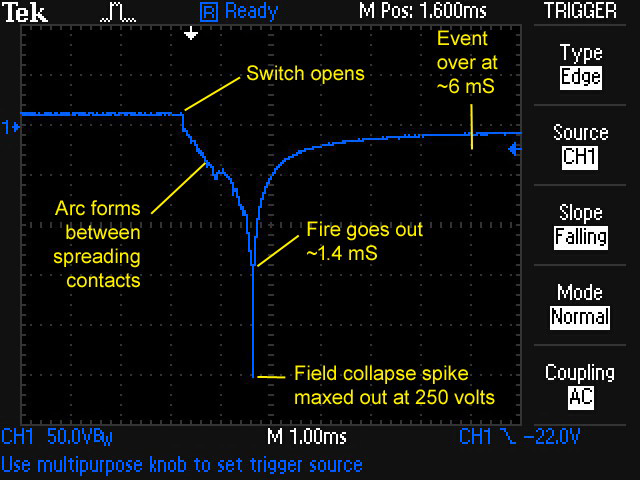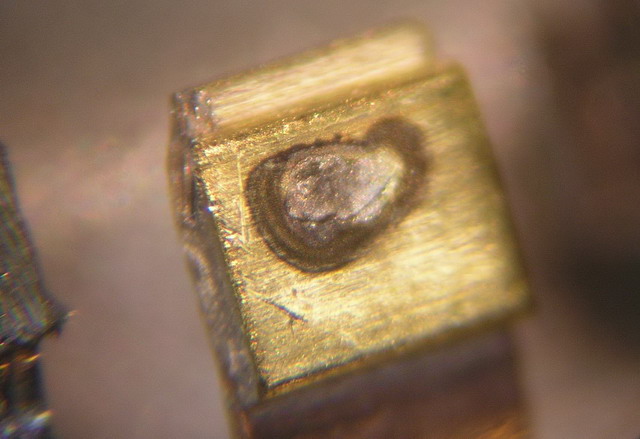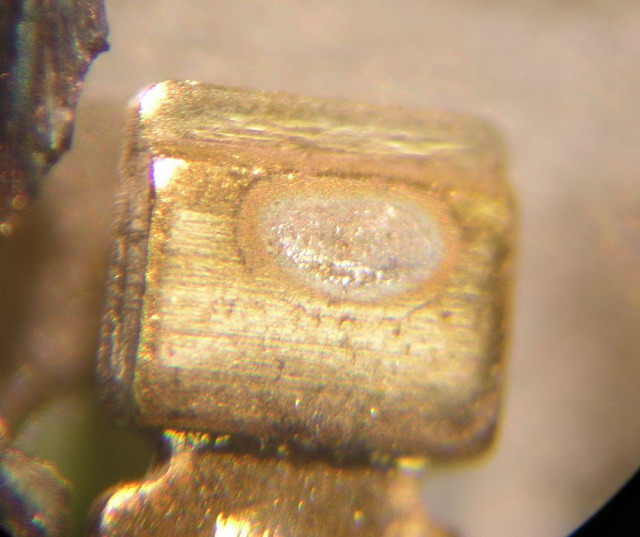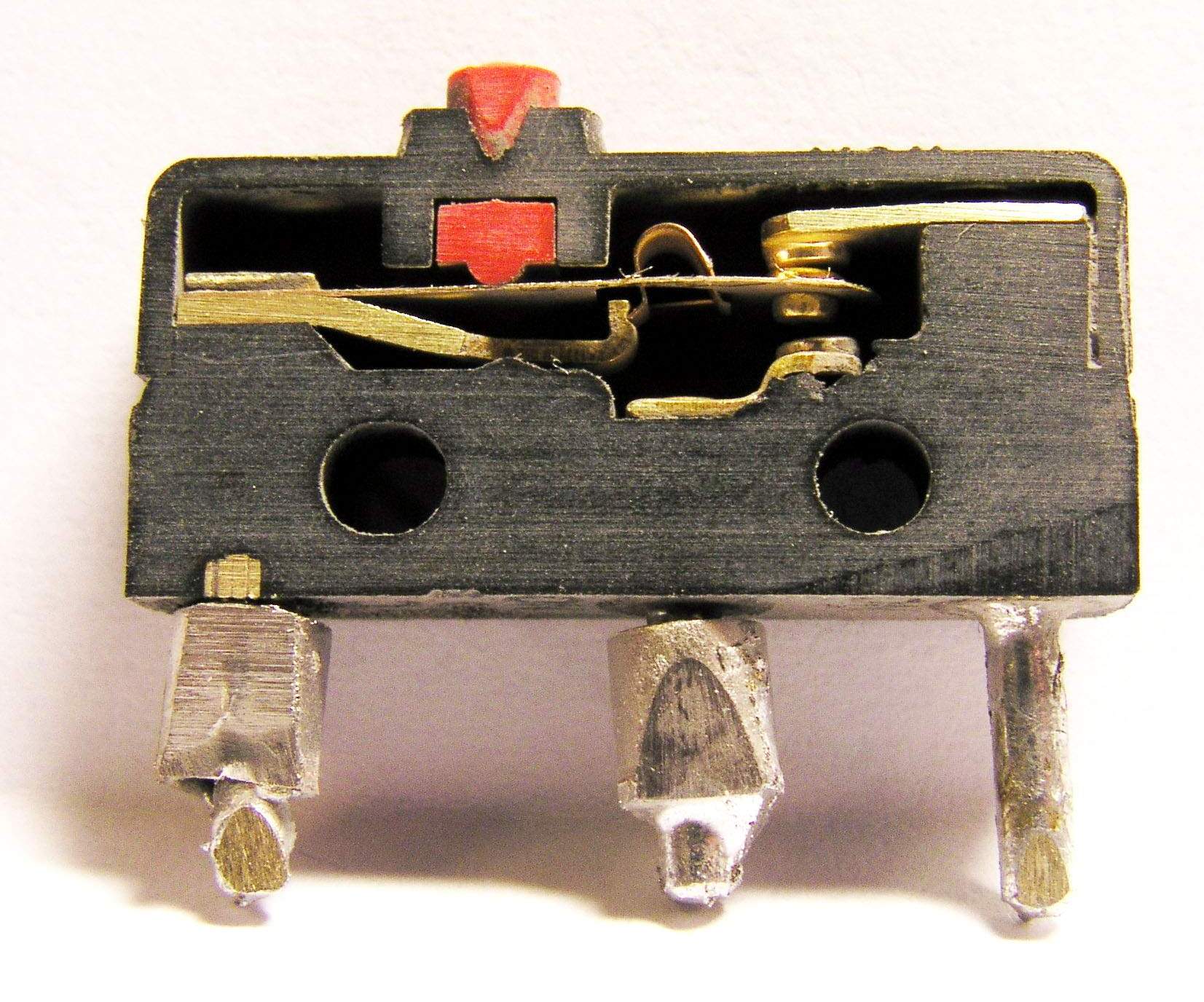 |
Matronics Email Lists
Web Forum Interface to the Matronics Email Lists
|
| View previous topic :: View next topic |
| Author |
Message |
nuckolls.bob(at)aeroelect
Guest
|
 Posted: Sun Apr 03, 2022 9:53 am Post subject: Spark suppression diode on starter MOTOR Posted: Sun Apr 03, 2022 9:53 am Post subject: Spark suppression diode on starter MOTOR |
 |
|
At 12:48 PM 4/2/2022, you wrote:
| Quote: | --> AeroElectric-List message posted by: "user9253" <fransew(at)gmail.com>
Batteries don't absorb the energy from inductive voltage spikes. |
Correct. A battery's ability to mitigate
hazardous stimuli in the electrical system
is limited to standing off a runaway power
generation system for the very short period
of time necessary for the o.v. protection
system to operate (hundreds of milliseconds).
This is a HIGH energy event (sometimes exceeding
10,000 watt-seconds).
"Spikes" are short duration (less than 10mS)
excursions generated by release of reactively
stored energy (usually inductive, sometimes
capacitive) and is a very low energy event
measured in millijoules (1/1000th of a watt-
seconds). These events are never a source
of catastrophic system damage. They will
sometimes manifest in transient mis-behavior
of a system that has NOT been qualified to
live in the legacy, aircraft electrical
environment.
| Quote: | The controlling switch contacts do. As the switch contacts open,
an arc jumps across the opening contacts. The energy is dissipated as heat. |
Some years back, we had some deep-dives into
physics and terminology of electrical transients
here on the List. I produced a number of bench-top
demonstrations illustrating the sources, effects and
mitigation of low energy transients (true spikes).
The attached plot was taken from one of those
experiments.
An S701 battery contactor coil collapse
spike was plotted while being controlled by
a toggle switch and NO coil suppression. Note
that the maximum excursion was on the order of
250 volts impresses across the spreading
contacts gap in the switch. An arc formed
between those contacts which persisted for
about 1.4 mS at which point the arc broke
and remaining energy took the transient to
its maximum excursion.
Energy dissipated in this even was on the order
of tens of millijoules. No single event
being hazardous to the switch . . . but hundreds
of events would eventually erode the switch's
contacts.
I couldn't quickly find examples of how much energy
from such events propagates out onto the system during
a de-energized non-suppressed coil event . . . but
I have measured it. It's TINY . . . 99.9% of the
energy is spent on the controlling device unless
managed with appropriate suppression. Even if the
battery WERE a valuable member of the spike suppression
community, there wouldn't be anything for it to do!
Two other images illustrate a study I did
at Beech on another contact failure investigation.
You can see the difference in burning and metal
transfer of controlling contacts with no
transient suppression on the loading device.
| Quote: | | Starter motors have counter EMF that might limit inductive voltage spikes. |
True . . . but they are still quite stressful on
their controlling device. This is why starter contactors
are specially crafted for DOUBLE break contacts
to increase contact spreading velocity for early
break of the inevitable albeit CEMF mitigated
arc.
Perhaps one MIGHT improve service life of a starter contactor
with some purposeful suppression of the arc but
the contactor designers have pretty well slain
that dragon.
Bob . . .
Un impeachable logic: George Carlin asked, "If black boxes
survive crashes, why don't they make the whole airplane
out of that stuff?"
| | - The Matronics AeroElectric-List Email Forum - | | | Use the List Feature Navigator to browse the many List utilities available such as the Email Subscriptions page, Archive Search & Download, 7-Day Browse, Chat, FAQ, Photoshare, and much more:
http://www.matronics.com/Navigator?AeroElectric-List |
|
| Description: |
|
| Filesize: |
186.4 KB |
| Viewed: |
2019 Time(s) |

|
| Description: |
|
| Filesize: |
58.44 KB |
| Viewed: |
2019 Time(s) |

|
| Description: |
|
| Filesize: |
78.34 KB |
| Viewed: |
2019 Time(s) |

|
|
|
| Back to top |
|
 |
nuckolls.bob(at)aeroelect
Guest
|
 Posted: Mon Apr 04, 2022 11:45 am Post subject: Spark suppression diode on starter MOTOR Posted: Mon Apr 04, 2022 11:45 am Post subject: Spark suppression diode on starter MOTOR |
 |
|
| Quote: |
Viewed another way, if we used a robust enough switch to control the relay,
with really fast acting contacts, we might be able to eliminate the
flyback diode from the relay coil. But the diode is much cheaper/simpler
than a switch that could handle the arc issue without damage.
Charlie |
Dead on. The only thing I would expand upon
is the term 'damage'. 'Wear' is the operative
term. I recall a demonstration I did many moons
ago where I switched a 1.5 volt flashlight cell
across a 1 ohms resistor.
Approx 1+ amps of current flow. I did this with
a sub-miniature, 'micro' switch with the side
sanded off so that one might observe the inner
workings.
While watching the contacts under a microscope
in a dark room, I could see a tiny arc between
the spreading contacts. The color of the arc
was blue . . . HOT. This suggests that for
even the smallest energy levels, the potential
for erosion of metal off the contact surfaces
is not zero; hence wear is not zero either.
Engineering applications data for all switches
will include predicted SERVICE LIFE values
for switches under various operating conditions.
See:
http://aeroelectric.com/articles/Switch_Ratings.pdf
Diodes didn't even start to show up in TC aircraft
until the late 60's. I was at Cessna when we
started fabricating diode assemblies to facilitate
installation in various places about the systems
including contactor coils.
I remember Gordon Wood (PhD in physics)
bought an HP peak-reading voltmeter and discovered
that some contactor coil spikes exceeded 400-500
volts! The fact that such a potential existed
was contrary to our pledge of compliance with
Mil-STD-704 . . . so began a program to mitigate
our 'transgression'. It had nothing to do with
life of the battery contactor switch . . .
that astounding spike that just had to be dealt with.
Don't recall any discussions about ENERGY nor
how it might have propagated into the system . . .
but we sure stomped out those spikes. Here's
a constellation of Cessna diode assemblies
dating from the 1960's to present day.
http://aeroelectric.com/Pictures/Cessna_Diode_Assy/
Are we not grateful NOT to own a TC aircraft?
Competent design is based on properties of materials,
management of energy and refinement of process.
But as we may observe in the photos cited above,
'refinement' hasn't really moved in the
right direction.
Bob . . .
Un impeachable logic: George Carlin asked, "If black boxes
survive crashes, why don't they make the whole airplane
out of that stuff?"
| | - The Matronics AeroElectric-List Email Forum - | | | Use the List Feature Navigator to browse the many List utilities available such as the Email Subscriptions page, Archive Search & Download, 7-Day Browse, Chat, FAQ, Photoshare, and much more:
http://www.matronics.com/Navigator?AeroElectric-List |
|
| Description: |
|
| Filesize: |
291.91 KB |
| Viewed: |
2004 Time(s) |

|
|
|
| Back to top |
|
 |
nuckolls.bob(at)aeroelect
Guest
|
 Posted: Tue Apr 05, 2022 7:26 am Post subject: Spark suppression diode on starter MOTOR Posted: Tue Apr 05, 2022 7:26 am Post subject: Spark suppression diode on starter MOTOR |
 |
|
At 03:11 AM 4/5/2022, you wrote:
| Quote: | ..and one should consider duty cycle?
On Mon, 4 Apr 2022 at 23:29, Robert L. Nuckolls, III < nuckolls.bob(at)aeroelectric.com (nuckolls.bob(at)aeroelectric.com)> wrote:
| Quote: |
Viewed another way, if we used a robust enough switch to control the relay,
with really fast acting contacts, we might be able to eliminate the
flyback diode from the relay coil. But the diode is much cheaper/simpler
than a switch that could handle the arc issue without damage.
Charlie |
|
Absolutely. Service life on switches (and relays) is
predicated on the type of load being managed by the
device. Those loads are divided into resistive (heaters),
inductive (coils and un-terminated transformers),
and lamp (high inrush like incandescent lamps, motors,
capacitive). There can be a huge variance of predicted
service life on the same switch over that range of
loads.
But note: Service lives are generally given in thousands
or tens of thousands of operations. After all, who would
even consider a switch rated for only 500 operations?
Service life numbers are critical to revenue generation
and risks for loss-of-vehicle (and the folks inside).
Hence, folks who design and maintain air transport
or military aircraft tend to migrate to the higher
numbers. It's not only a matter of safety but cost
of operation. The boss is really unhappy when a $million$
machine is down for lost functionality in a $10 switch.
We who fly around in machines with lower criticality
can reduce hazard with failure mode effects analysis
while mitigating expense with owner built and maintained
aircraft.
Back to that duty-cycle thingy. Over the lifetime
of the airplane, how many times will the most exercised
switch be operated? Hmmm . . . battery master? Landing
gear? Trim switch? Last stat I read (many moons ago)
was that the typical light aircraft is flown 50 hrs
a year. How many flight cycles is that? What's
the probability of using up all nine-lives of the
most severely stressed switch in the airplane?
Those are all questions for which we can apply no
specific numbers . . . our designs and utilization
goals are anything but 'average'. But with attention
to simple details and diligent preventative
maintenance, risk for an unhappy day in the cockpit
due to electrical issues is exceeding small compared
to fuel exhaustion, weather, poor mission
planning, etc.
Bottom line is that pleasures to be secured
with the operation of your airplane has much
more to do with being a pilot than with worrying
about diodes on the relays.
Bob . . .
Un impeachable logic: George Carlin asked, "If black boxes
survive crashes, why don't they make the whole airplane
out of that stuff?"
| | - The Matronics AeroElectric-List Email Forum - | | | Use the List Feature Navigator to browse the many List utilities available such as the Email Subscriptions page, Archive Search & Download, 7-Day Browse, Chat, FAQ, Photoshare, and much more:
http://www.matronics.com/Navigator?AeroElectric-List |
|
|
|
| Back to top |
|
 |
|
|
You cannot post new topics in this forum
You cannot reply to topics in this forum
You cannot edit your posts in this forum
You cannot delete your posts in this forum
You cannot vote in polls in this forum
You cannot attach files in this forum
You can download files in this forum
|
Powered by phpBB © 2001, 2005 phpBB Group
|






